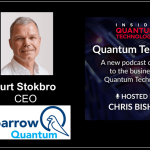Quantum News Briefs: January 3, 2023: QuantrolOx Releases Their First Product, Quantum Edge Asparagus; U.S. Department of Energy Looks at Quantum Vortexes; 3 Quantum Computing Stocks to Tap into the Future in 2024; and MORE!

Quantum News Briefs: January 3rd, 2023:
QuantrolOx Releases Their First Product, Quantum Edge Asparagus

QuantrolOx has unveiled Quantum Edge Asparagus, a revolutionary software platform that automates qubit control in quantum computers. This platform significantly simplifies the increasingly complex task of tuning and calibrating quantum computers as they scale up in qubit numbers. Quantum Edge Asparagus works with control electronics from Qblox and Quantum Machines and plans to expand compatibility. The software’s core features include Quantum Processing Unit (QPU) Monitoring, Automation Workflows, and advanced Data Visualizations. These functionalities facilitate rapid and efficient execution of complex quantum operations and experiments, such as resonator and qubit spectroscopy and randomized benchmarking. The software also provides a graphical representation of QPU topology, allowing for real-time progress tracking and detailed analysis of each control segment in the workflow. This innovation in quantum computing offers a streamlined, user-friendly approach to managing and analyzing quantum data, enhancing the efficiency and capabilities of quantum hardware development.
U.S. Department of Energy Looks at Quantum Vortexes
In a significant study, scientists at the U.S. Department of Energy discovered that matter within neutron stars can transform into different states: either as a dense liquid of nucleons or quarks. This research challenges long-standing theories in quantum chromodynamics (QCD) by revealing that quark liquids differ fundamentally from nucleon liquids due to the unique “color-magnetic field” in their vortices, a phenomenon not observed in nucleon liquids. This finding sheds new light on the nature of confinement in quantum physics, a concept that describes how quarks are perpetually bound together, never existing individually. The study uses advanced theoretical calculations and new tools developed over the past 40 years to identify topological transitions in materials to demonstrate that quark and nuclear matter are indeed distinct. This contrasts with the older Landau paradigm for phase transitions, which suggested that nuclear and quark matter were not separate. The ability to distinguish quark matter from nuclear matter based on the properties of their vortices provides a clearer understanding of dense QCD. It suggests that confinement can be precisely defined in these extreme environments.
Quantum thermal transistors: Harnessing quantum measurement and feedback
Researchers at Monash University and JPL are making significant strides in quantum systems and materials, focusing on dynamic manipulation to achieve breakthroughs in energy management and conservation. A key area of this research is the development of quantum thermal transistors, advanced devices designed for precise heat transfer management. These transistors are critical in addressing the cooling and environmental regulation challenges faced by quantum computers and other qubit technologies. The innovative concept of a conditioned quantum thermal transistor has been introduced, continuously monitored, and adjusted according to its environment. This development involves a stochastic noise model, similar to those used in classical transistors, to understand better and manage the fluctuations and perturbations affecting these small-scale devices. The research, published in Physical Review B, is still in its early stages, but it represents a groundbreaking step toward creating efficient heat management systems in quantum technology. This research is part of the scientific community’s ongoing effort to integrate quantum feedback mechanisms into thermal transistors, which differ significantly from classical feedback systems, with the ultimate goal of innovating more efficient energy solutions.
In Other News: Investor Place article: “3 Quantum Computing Stocks to Tap into the Future in 2024”
![]()
As 2024 unfolds, quantum computing stocks are becoming increasingly significant in the tech industry, with several key players emerging as disruptive forces, a recent Investor Place article notes. IonQ (IONQ) is notable for being the first pure-play public quantum computing company, boasting impressive collaborations with major cloud providers and demonstrating strong financial growth, including a 122% year-over-year revenue increase in the third quarter. Nvidia (NVDA) is another major player, renowned for its pioneering H100 chips in AI and the much-anticipated H200, which marks its entry into quantum computing with projects like cuQuantum. These developments are expected to boost Nvidia’s long-term investment potential significantly. Alphabet (GOOG, GOOGL) is also making significant strides, particularly with its breakthrough in quantum computing error reduction, a critical step towards commercial viability. Alphabet’s strong financial performance, including reorganizing its advertising business and introducing new AI models, positions it as a strong contender in both quantum computing and AI. These companies represent the forefront of the quantum computing revolution, offering promising opportunities for investors interested in tapping into this cutting-edge technology.
In Other News: Silicon Republic article: “A banner year for quantum computing: What to expect in 2024”
In a recent Silicon Republic article, Tim Callan from Sectigo forecasts that 2024 will be a pivotal year for quantum computing and encryption as the field transitions from theoretical exploration to practical engineering. A significant focus will be on the RSA encryption algorithm, which will face intense scrutiny and efforts to break its security, especially with the advancements in quantum computing. While RSA is not expected to be defeated imminently, the ongoing research in this area will gradually pave the way for quantum-based attacks. This situation will intensify discussions about post-quantum cryptography (PQC) in corporate boardrooms as companies, particularly in sensitive sectors, start preparing to transition to quantum-resistant encryption. These preparations are largely driven by the US National Institute of Standards and Technology’s (NIST) development of quantum-resistant encryption standards and educational campaigns about the potential threats posed by quantum computing to current encryption methods. Additionally, the need for governments to increase their investment in quantum computing and security is emphasized, with a warning about the potential risks and opportunities that quantum computing presents to national and corporate security. This shift marks a significant turn in the perception and application of quantum computing in business and security realms.
Kenna Hughes-Castleberry is the Managing Editor at Inside Quantum Technology and the Science Communicator at JILA (a partnership between the University of Colorado Boulder and NIST). Her writing beats include deep tech, quantum computing, and AI. Her work has been featured in Scientific American, Discover Magazine, New Scientist, Ars Technica, and more.



















